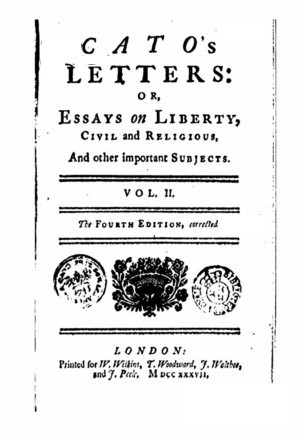Cato's Letters facts for kids
Cato's Letters were a series of important essays. They were written by two British writers, John Trenchard and Thomas Gordon. They used the fake name, or pseudonym, of Cato. This name came from a famous Roman, Cato, who lived a long time ago (95–46 BC). Cato was known for being a strong supporter of republican ideas and stood against powerful leaders like Julius Caesar. These essays were published between 1720 and 1723.
Contents
Why Were Cato's Letters Written?
The Letters are seen as a very important work. They belong to a group of ideas from thinkers called the Commonwealth men. There were 144 essays in total. They first appeared in the London Journal. Later, they were published in the British Journal.
These essays strongly criticized the British political system. They spoke out against corruption and a lack of good morals. They also warned people about leaders who might become too powerful. The writers wanted to prevent unfair rule and the abuse of power.
How Cato's Letters Were Published
The Letters were later collected and printed as a book. Its full title was Essays on Liberty, Civil and Religious. These essays became very popular. By 1755, the book had been printed six times. This shows how much people read and valued them.
Many years later, their ideas greatly influenced the American Revolution. Historian Peter Karsten noted how important they were. He said Cato's Letters were often found in the libraries of America's founding fathers.
How Cato's Letters Influenced America
These letters gave a lot of ideas and inspiration to the people who started the American Revolution. The essays were shared widely across the Thirteen Colonies. People often quoted them in newspapers. You could find them in cities from Boston to Savannah, Georgia.
A famous historian, Clinton Rossiter, said something important. He explained that Cato's Letters were more popular than John Locke's Civil Government. He said they were the most quoted and respected source for political ideas in the colonies.
The Cato Institute is a Washington, D.C., think tank. It was started by Edward H. Crane in 1977. This group was named after Cato's Letters. This shows their lasting influence.
Other Writers Using the Name "Cato"
It's interesting that other writers in America also used "Cato" as a fake name. These letters were not connected to the original Trenchard and Gordon essays.
One "Cato" wrote essays in 1776. These essays argued against America becoming independent. They appeared in the Pennsylvania Gazette. Some historians believe this "Cato" was Reverend Dr. William Smith. He was an important Anglican minister in Philadelphia. His ideas were challenged by letters signed "The Forester," which was likely Thomas Paine.
Later, "Cato" was used again in 1787 and 1788. These letters were published in the New York Journal. They argued against James Madison's ideas. They also urged people not to approve the United States Constitution. This view was known as Anti-Federalism. Many historians think these letters were written by George Clinton. However, we don't know for sure who wrote them. Alexander Hamilton wrote responses to these letters. He used the fake name "Caesar."
See also
 In Spanish: Cartas de Catón para niños
In Spanish: Cartas de Catón para niños


